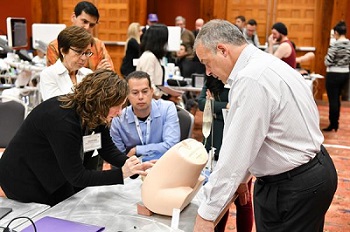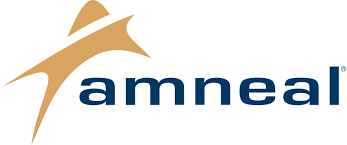
April 25-26, 2025
Rosemont, IL
This two-day course is an intensive, hands-on program that will elevate the attendee’s knowledge and skills in the evaluation and management of spasticity and other forms of muscle overactivity. Strategies to differentiate and identify patterns of presentation and different focal and regional interventions that include neurolytic agents, neurotoxins and intrathecal medications will be discussed. World class faculty will guide small groups during hands-on training sessions. Upon completion of this course, attendees should be capable of planning and executing these procedures with a higher degree of confidence and efficiency.
Directors and Faculty
(SUBJECT TO CHANGE)
Directors
Alberto Esquenazi, MD, FAAPMR
Michael F. Saulino, MD, PhD, FAAPMR
Faculty
Kristin E. Caldera, DO
Reza Farid, MD
Cindy B. Ivanhoe, MD
Lindsay E. Mohney, DO
Daniel Moon, MD, MS
Marilyn S. Pacheco, MD
Stephen T. Porter, MD
Mary E. Russell, DO, MS
Andrea P. Toomer, MD
Monica Verduzco-Gutierrez, MD
Thomas K. Watanabe, MD
Thank You to Our Exhibit Sponsors!



Learning Objectives
At the completion of this course, participants will be able to:
- Identify and apply interventional techniques for management of upper and lower extremity spasticity patterns
- Utilize ultrasound, EMG and electrical stimulation guidance to perform focal chemodenervation techniques
- Identify and apply interventional techniques for management of spasticity with intrathecal baclofen therapy
- Describe various imaging techniques to troubleshoot intrathecal delivery systems
Agenda
(SUBJECT TO CHANGE)
Friday, April 25
7-8 am Registration / Breakfast Available
8-8:15 am Welcome and Introduction
8:15-8:45 am Incidence and Presentation Based on Diagnosis
8:45-9:15 am Focal Interventional Treatment Considerations
9:15-10:15 am Hands-On Skills Training: Session 1
10:15-10:30 am Break
10:30-11:30 am Hands-On Skills Training: Session 2
11:30 am-12:30 pm Hands-On Skills Training: Session 3
12:30-1:30 pm Lunch
1:30-2 pm Case-based Discussion: Diplegic Cerebral Palsy Leading to Lower Extremity
Neurolysis
2-3 pm Hands-On Skills Training: Session 4
3-3:15 pm Break
3:15-4:15 pm Hands-On Skills Training: Session 5
4:15-5 pm Case-based Discussion: Spinal Cord Injury Paraplegia Leading to Intrathecal
Baclofen Therapy
5-5:15 pm Review of the Day - Q&A
Saturday, April 26
7:15-8 am Breakfast Available
8-9 am Hands-On Skills Training: Session 6
9-10 am Hands-On Skills Training: Session 7
10-10:15 am Break
10:15-11:15 am Hands-On Skills Training: Session 8
11:15-11:45 am Case-based Discussion: Hemiplegic Stroke Leading to Upper Extremity
Chemodenervation
11:45 am-12:15 pm Case-based Discussion: Multiple Sclerosis Quadriparesis Leading to Intrathecal
Baclofen Disruption
12:15-1:15 pm Lunch
1:15-3 pm Focused Skills Training Sessions
3-3:15 pm Break
3:15-4:45 pm Focused Skills Training Sessions (Continued)
4:45-5 pm Debriefing with Q&A
Hands-on Skills Training Sessions
Friday afternoon and Saturday morning will focus on:
- Pump refill with visual / palpation techniques as well as drug preparation
- Pump basic and advanced programming
- Catheter port access with visual / palpation techniques
- Lumbar puncture on a simulation model
- Ultrasound guidance for reservoir and catheter access port
- Radiographic review of pump troubleshooting techniques
- Upper and lower limb muscle identification focusing on commonly encountered patterns with simulated injections on simulation models
- Ultrasound guidance for upper and lower limb muscle and nerve localization
- Upper and lower limb nerve localization with electrical stimulation
Focused Skills Training
Saturday afternoon will feature a focused training sessions covering unusual chemodenervation and neurolytic techniques when severe deformities are present (toxin dilution and volume adjustment to optimize effect, motor point vs nerve block, individual finger flexor fascicles, and importance of toe flexors on gait improvement) and cervical dystonia treatment with ultrasound guided muscle identification and simulated injections.
Agenda Breakdown
- Up to 15.25 AMA PRA Category 1 Credits™ — MOC approved!
- 6 dynamic lectures and case-based discussions
- 11 hours of hands-on, diagnostic and interventional procedures
Accreditation:
The American Academy of Physical Medicine and Rehabilitation is accredited by the Accreditation Council for Continuing Medical Education (ACCME) to provide continuing medical education for physicians.
Designation of Credit:
The American Academy of Physical Medicine and Rehabilitation (AAPM&R) designates this live activity for a maximum of 15.25 AMA PRA Category 1 Credits™. Physicians should only claim credit commensurate with the extent of their participation in the activity.
This course has been approved by the American Board of Physical Medicine and Rehabilitation (ABPMR) for a maximum of 15.25 Maintenance of Certification® (MOC®) Part II Self-Assessment credits. Attendees must actively participate and complete a self-evaluation at the conclusion of the course to earn MOC Part II credit.
Hotel Information
Hilton Rosemont/Chicago O'Hare
5550 N. River Rd.
Rosemont, IL 60018
Book before Thursday, April 10, 2025, to receive our discounted rate of $149 per night (plus tax). You can book by clicking the "Reserve a Room" link below.
Air Travel
As an option, air travel reservations may be made by calling TruTravel Solutions, the official travel partner for AAPM&R. TruTravel Solutions charges a $25 per ticket transaction fee.
Jennifer Schaller
Direct line: 312-224-7048
Email: jennifer@tru-trav.com
Saira Flores
Direct line: 312-224-8365
Email: saira@tru-trav.com
TruTravel Solutions hours are Monday – Friday, 8:30 am-5 pm (Central Time).
Course Check-In
Course check-in will be on Friday, April 25, 2025, from 7-8 am where course badges will be provided.
Meals
Breakfast items and lunch will be served on both days of the course.
Attire
Attendees are encouraged to dress comfortably. Scrubs are not required.
Cancellation and Change Policy
All cancellations for the Interventional Spasticity Management Applications Course must be submitted in writing via email to education@aapmr.org or via mail postmarked by March 14, 2025 to:
American Academy of Physical Medicine and Rehabilitation
Attention: Education Department
9700 W. Bryn Mawr Avenue, Suite 200
Rosemont, IL 60018
We look forward to your participation! Please contact education@aapmr.org with any questions.
Registration
Click the button below to register for the 2025 April Interventional Spasticity Management Applications Course, which is Step 2 of the full STEP Interventional Spasticity Certificate Program.
PLEASE NOTE - By registering for this course, you are enrolling in the full certificate program. A la carte registration for this course is not available.
Looking for Sponsorship Opportunities?
Click the button below or email corporatesupport@aapmr.org.